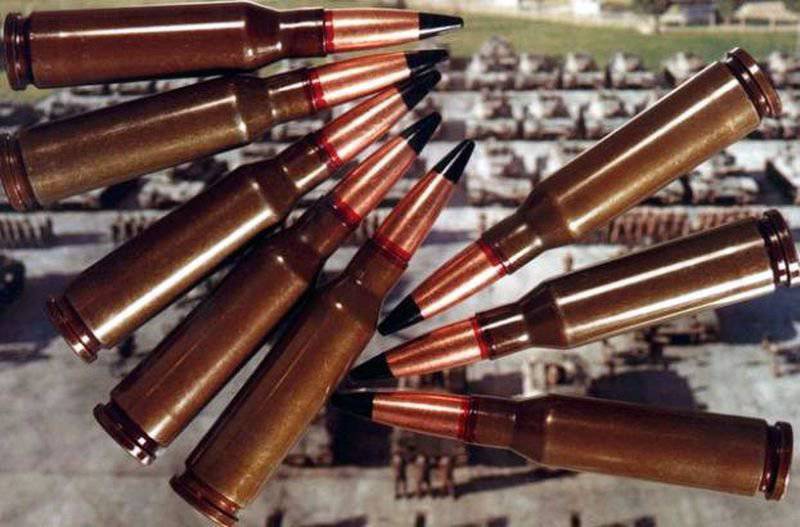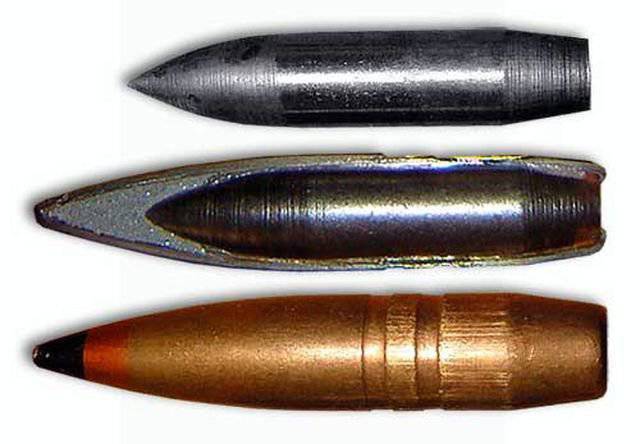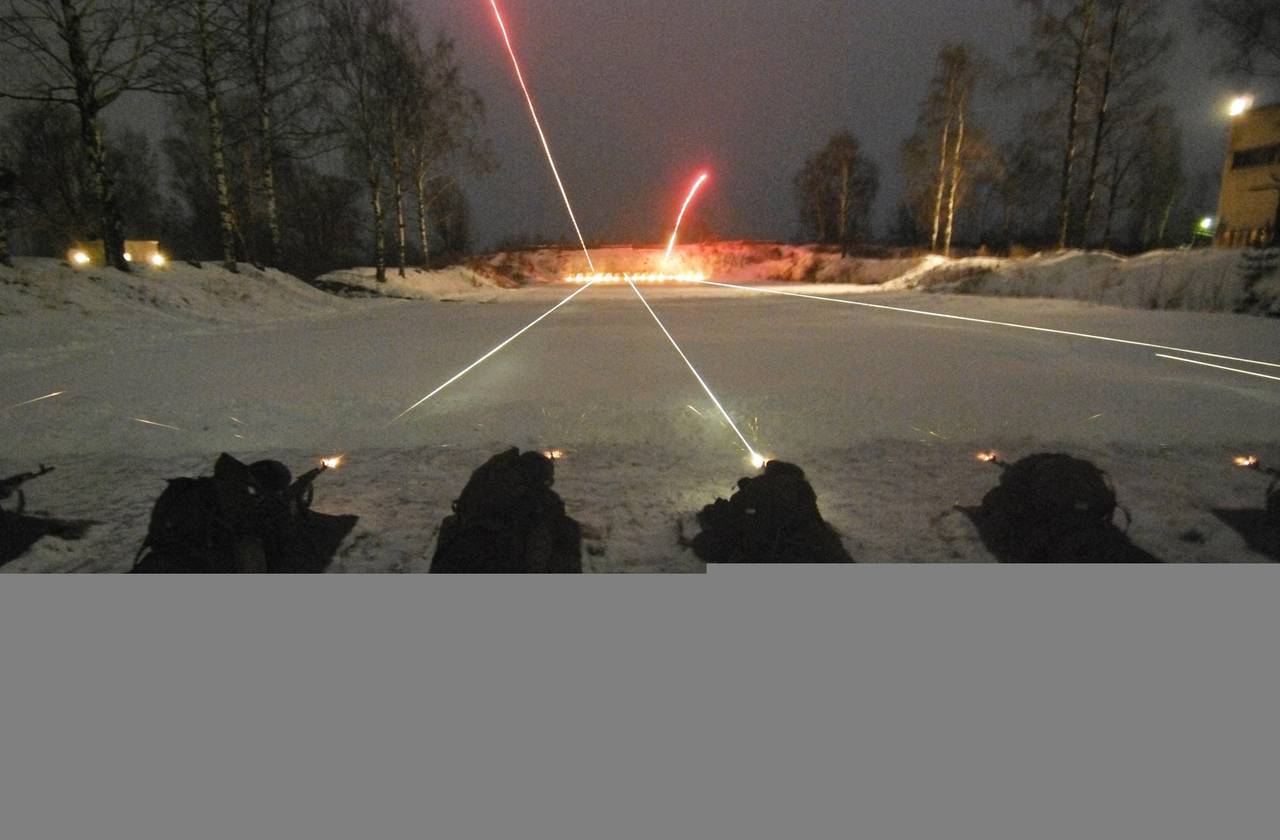TS
boleroes11
Armour Piercing Ammo
Armor piercing bullets
During combat operations soldier can not do without various special purpose bullets: armor-piercing, tracer, incendiary, etc. Below we will focus on armor-piercing ammunition for small arms. The main purpose of armor-piercing bullets on the battlefield is to increase the probability of penetration of various obstacles, such as board and chassis vehicles, personal protective equipment, and various shelters. Such bullets are special ammunition, which expands the tactical possibilities of small arms.
In the simplest embodiment, armor-piercing bullet pistol completely made of a material Bole harder than lead, for example, made of brass or steel. The use of such bullets accelerates wear gun barrel because most of the applied normal option obolochnoy bullets in which a part or all of the lead core is replaced by a core made of steel or a hard alloy. In some versions of the domestic anti-armor ammunition for small arms in the head of the bullet hard core is not covered with skin, to breaking through a barrier energy is not spent on the deformation and breaking of the shell itself core bullets. At the same time if it enters into any unprotected goal armor munitions behave exactly like a shell of the bullet with the same characteristics (speed and mass).
For example, the Russian pistol cartridges (5.45-mm cartridge PSM, 7.62-mm cartridge TT and 9-mm cartridge PM) have in their family to conventional lead bullets and steel-core armor-piercing. In addition to fabrication of steel core bullet can be used as tungsten carbide. This material is 30% denser than lead and harder than steel, its main disadvantage is the high cost, due to the complexity and cost of processing tungsten carbide. Another promising material for the development of the cores is depleted uranium, which has an additional damaging effect.

Armor piercing bullets in comparison with conventional ammunition offer inferior ballistic qualities. Since such bullets lighter than lead, they are worse than the "hold" in the conduct of the trajectory fire at long range, they have a greater dispersion. Their disadvantage is a small efficiency in the management of fire on unarmored targets. Armor piercing bullets feature low stopping power. This bullet has a smaller kinetic energy (due to the smaller mass), and its shape does not change when in contact with human body. Despite this armor piercing bullets are in service today almost all armies in the world and regarded as a fairly useful kind of ammunition, particularly in relation to the increasing incidence of military body armor (vests).
Thus the first armor piercing bullets were invented long before the first battlefield of personal body armor. Initially such bullets were meant mainly to combat armored vehicles. Even during World War I with the advent of the first on the battlefield armored vehicles and tanks have a problem effectively combat them using small arms. Armor first tanks, not to mention ordinary armored vehicles, that period could protect the crew and machine components only from bullets and shrapnel. Fire machine guns and rifles ordinary lead bullets were useless against even the lightest armor. But gunsmiths could very quickly find a way out of this situation. They increased the strength of the bullet through the inclusion of its construction steel core.
The Second World War and all subsequent her local wars and conflicts have demonstrated the increased importance of the use of armor-piercing bullets for handguns (pistols, machine guns, rifles, machine guns), and heavy machine guns, which can be used as an effective tool to support the infantry on the battlefield ( machine guns) or armament armored vehicles, helicopters, drones and aircraft.

12.7 mm bullet 57-BZ-542 in the context of
One of the most important characteristics for any armor piercing bullet is its breakout or breakdown action. Breakdown action - this is the depth of penetration of bullets into the target, having a certain density. This feature depends on the ammunition caliber bullet, its mass, initial velocity, designs and shapes, with the angle between the barrier and its density. The greatest effect of any breakdown armor-piercing bullet shows an angle of meeting with a barrier of about 90 degrees. No wonder designers prefer the use of armored vehicles sloping armor, which provides it with the highest level of protection against various types of armor-piercing ammunition penetrating.
Highest caliber cartridges have broneprobitiem 12.7mm. For example, widespread 12.7 mm armor-piercing incendiary cartridge 57-BZ-542, which is used in the NSV-12, 7 "cliff", "Kord" or large-caliber sniper rifles KAFP "Kord", capable of penetrating up to 20 mm armor at distances up to 100 meters. Current breaks armored plate thickness not less than 90% of cases. In this incendiary effect on petrol bullet located in the 15th armor plate at a distance of 70 meters is at least 75%. Distinguish domestic from conventional armor-piercing bullet is quite simple, its upper part is painted black. Do armor-piercing/incendiary tipped bullets under black has red bordering strip.
In the creation of armor-piercing ammunition for small arms our weapon occupy its rightful place, and Russia is one of the leaders in this area. Our gunsmiths have managed to create a number of armor-piercing rounds to all the major models of Russian small arms, ranging from 7.62 and 12.7 mm armor-piercing rounds (40-50s) and ending with modern 5,45 x39, 9x21 and 9h39-mm armor-piercing cartridges. At the same time Soviet and Russian designers have developed not only armor-piercing ammunition with high penetrating ability, but also to ensure a sufficiently high accuracy of firing bullets in the complex design that is quite difficult to achieve technologically.

In modern armies armor piercing bullets used primarily for fighting manpower of the enemy, protected by means of body armor or are located in a variety of shelters, to destroy unarmored and light armored transport and fire weapons, as well as to engage various airborne targets. Particularly relevant was the use of armor-piercing bullets in the 1970's and 80's, when armed with modern armies began to appear en masse personal body armor in the first place - bulletproof vests.
Core piercing bullets are generally manufactured from various grades of high-carbon steel and its alloys (high-alloyed steel with the addition of tungsten). In this core armor piercing bullet is inside her body (shell) in a special lead shirt that gives him a fixed position and facilitates the penetration of the bullet rifling of the barrel, the barrel protecting himself from premature wear. Most often, an armor piercing bullet shell made of bimetal. In the vast majority of modern bullets used red brass alloy, which is 89-91% consists of copper and 11.9% zinc. Armor-piercing rounds sleeve is no different from ordinary, they are made of mild steel or brass lacquered or red brass. As the propellant in all modern small arms ammunition used pyroxyline gunpowder.
In most modern armor piercing ammunition action combined with incendiary (such bullets are called armor-piercing incendiary) and tracer (armor-piercing incendiary tracer or armor-piercing tracer). Such munitions combine the optimal armor-piercing incendiary effect from. Most often incendiary composition is placed in the rear of the bullet and is a hypergolic substance having elevated initiating properties.

In the role of modern warfare such munitions to combat manpower of the enemy, flak vest, has increased significantly. However, to fully ensure that small arms only armor-piercing ammunition makes no sense, since they are more expensive to manufacture, and the actual fighting require that a soldier's ammunition cartridges having different characteristics. For successful performance of combat missions submachine gun belts or stores can equip oneself various ammunition, followed by interleaved.
For example, for the conduct of night fighting machine or a machine gun, you can equip one cartridge with a tracer bullet, two with regular bullet and one with armor-piercing bullets and so on. If a soldier or unit requires stealth, then the gear shops and ribbons conventional bullets can be alternated with armor-piercing incendiary. For example, in the mountains during the day and night using armor-piercing incendiary bullets comfortably adjust fire, guided by discontinuities such bullets with stones. To effectively engage aerial targets every third or second cartridge should be tracer.
Sources of information:
http://vooruzhen.ru/news/139/6172
http://www.straikbol.ru/weapons_and_...ynye-puli.html
http://world.guns.ru/ammunition/pist...tridges-r.html
http://vitaly.chuyakov.ru/337-puli-b...jushhie-i.html
=========================
Peluru AP kaliber kecil dan sedang, merupakan "momok" bagi perorangan yg memakai baju anti peluru atau bagi kendaraan lapis baja dengan ketebalan baja relative tipis.
Apakah PT PINDAD juga sudah memproduksi peluru semacam?
Salam.
During combat operations soldier can not do without various special purpose bullets: armor-piercing, tracer, incendiary, etc. Below we will focus on armor-piercing ammunition for small arms. The main purpose of armor-piercing bullets on the battlefield is to increase the probability of penetration of various obstacles, such as board and chassis vehicles, personal protective equipment, and various shelters. Such bullets are special ammunition, which expands the tactical possibilities of small arms.
In the simplest embodiment, armor-piercing bullet pistol completely made of a material Bole harder than lead, for example, made of brass or steel. The use of such bullets accelerates wear gun barrel because most of the applied normal option obolochnoy bullets in which a part or all of the lead core is replaced by a core made of steel or a hard alloy. In some versions of the domestic anti-armor ammunition for small arms in the head of the bullet hard core is not covered with skin, to breaking through a barrier energy is not spent on the deformation and breaking of the shell itself core bullets. At the same time if it enters into any unprotected goal armor munitions behave exactly like a shell of the bullet with the same characteristics (speed and mass).
For example, the Russian pistol cartridges (5.45-mm cartridge PSM, 7.62-mm cartridge TT and 9-mm cartridge PM) have in their family to conventional lead bullets and steel-core armor-piercing. In addition to fabrication of steel core bullet can be used as tungsten carbide. This material is 30% denser than lead and harder than steel, its main disadvantage is the high cost, due to the complexity and cost of processing tungsten carbide. Another promising material for the development of the cores is depleted uranium, which has an additional damaging effect.

Armor piercing bullets in comparison with conventional ammunition offer inferior ballistic qualities. Since such bullets lighter than lead, they are worse than the "hold" in the conduct of the trajectory fire at long range, they have a greater dispersion. Their disadvantage is a small efficiency in the management of fire on unarmored targets. Armor piercing bullets feature low stopping power. This bullet has a smaller kinetic energy (due to the smaller mass), and its shape does not change when in contact with human body. Despite this armor piercing bullets are in service today almost all armies in the world and regarded as a fairly useful kind of ammunition, particularly in relation to the increasing incidence of military body armor (vests).
Thus the first armor piercing bullets were invented long before the first battlefield of personal body armor. Initially such bullets were meant mainly to combat armored vehicles. Even during World War I with the advent of the first on the battlefield armored vehicles and tanks have a problem effectively combat them using small arms. Armor first tanks, not to mention ordinary armored vehicles, that period could protect the crew and machine components only from bullets and shrapnel. Fire machine guns and rifles ordinary lead bullets were useless against even the lightest armor. But gunsmiths could very quickly find a way out of this situation. They increased the strength of the bullet through the inclusion of its construction steel core.
The Second World War and all subsequent her local wars and conflicts have demonstrated the increased importance of the use of armor-piercing bullets for handguns (pistols, machine guns, rifles, machine guns), and heavy machine guns, which can be used as an effective tool to support the infantry on the battlefield ( machine guns) or armament armored vehicles, helicopters, drones and aircraft.

12.7 mm bullet 57-BZ-542 in the context of
One of the most important characteristics for any armor piercing bullet is its breakout or breakdown action. Breakdown action - this is the depth of penetration of bullets into the target, having a certain density. This feature depends on the ammunition caliber bullet, its mass, initial velocity, designs and shapes, with the angle between the barrier and its density. The greatest effect of any breakdown armor-piercing bullet shows an angle of meeting with a barrier of about 90 degrees. No wonder designers prefer the use of armored vehicles sloping armor, which provides it with the highest level of protection against various types of armor-piercing ammunition penetrating.
Highest caliber cartridges have broneprobitiem 12.7mm. For example, widespread 12.7 mm armor-piercing incendiary cartridge 57-BZ-542, which is used in the NSV-12, 7 "cliff", "Kord" or large-caliber sniper rifles KAFP "Kord", capable of penetrating up to 20 mm armor at distances up to 100 meters. Current breaks armored plate thickness not less than 90% of cases. In this incendiary effect on petrol bullet located in the 15th armor plate at a distance of 70 meters is at least 75%. Distinguish domestic from conventional armor-piercing bullet is quite simple, its upper part is painted black. Do armor-piercing/incendiary tipped bullets under black has red bordering strip.
In the creation of armor-piercing ammunition for small arms our weapon occupy its rightful place, and Russia is one of the leaders in this area. Our gunsmiths have managed to create a number of armor-piercing rounds to all the major models of Russian small arms, ranging from 7.62 and 12.7 mm armor-piercing rounds (40-50s) and ending with modern 5,45 x39, 9x21 and 9h39-mm armor-piercing cartridges. At the same time Soviet and Russian designers have developed not only armor-piercing ammunition with high penetrating ability, but also to ensure a sufficiently high accuracy of firing bullets in the complex design that is quite difficult to achieve technologically.

In modern armies armor piercing bullets used primarily for fighting manpower of the enemy, protected by means of body armor or are located in a variety of shelters, to destroy unarmored and light armored transport and fire weapons, as well as to engage various airborne targets. Particularly relevant was the use of armor-piercing bullets in the 1970's and 80's, when armed with modern armies began to appear en masse personal body armor in the first place - bulletproof vests.
Core piercing bullets are generally manufactured from various grades of high-carbon steel and its alloys (high-alloyed steel with the addition of tungsten). In this core armor piercing bullet is inside her body (shell) in a special lead shirt that gives him a fixed position and facilitates the penetration of the bullet rifling of the barrel, the barrel protecting himself from premature wear. Most often, an armor piercing bullet shell made of bimetal. In the vast majority of modern bullets used red brass alloy, which is 89-91% consists of copper and 11.9% zinc. Armor-piercing rounds sleeve is no different from ordinary, they are made of mild steel or brass lacquered or red brass. As the propellant in all modern small arms ammunition used pyroxyline gunpowder.
In most modern armor piercing ammunition action combined with incendiary (such bullets are called armor-piercing incendiary) and tracer (armor-piercing incendiary tracer or armor-piercing tracer). Such munitions combine the optimal armor-piercing incendiary effect from. Most often incendiary composition is placed in the rear of the bullet and is a hypergolic substance having elevated initiating properties.

In the role of modern warfare such munitions to combat manpower of the enemy, flak vest, has increased significantly. However, to fully ensure that small arms only armor-piercing ammunition makes no sense, since they are more expensive to manufacture, and the actual fighting require that a soldier's ammunition cartridges having different characteristics. For successful performance of combat missions submachine gun belts or stores can equip oneself various ammunition, followed by interleaved.
For example, for the conduct of night fighting machine or a machine gun, you can equip one cartridge with a tracer bullet, two with regular bullet and one with armor-piercing bullets and so on. If a soldier or unit requires stealth, then the gear shops and ribbons conventional bullets can be alternated with armor-piercing incendiary. For example, in the mountains during the day and night using armor-piercing incendiary bullets comfortably adjust fire, guided by discontinuities such bullets with stones. To effectively engage aerial targets every third or second cartridge should be tracer.
Sources of information:
http://vooruzhen.ru/news/139/6172
http://www.straikbol.ru/weapons_and_...ynye-puli.html
http://world.guns.ru/ammunition/pist...tridges-r.html
http://vitaly.chuyakov.ru/337-puli-b...jushhie-i.html
=========================
Peluru AP kaliber kecil dan sedang, merupakan "momok" bagi perorangan yg memakai baju anti peluru atau bagi kendaraan lapis baja dengan ketebalan baja relative tipis.
Apakah PT PINDAD juga sudah memproduksi peluru semacam?
Salam.
0
5.7K
15
Thread Digembok
Urutan
Terbaru
Terlama
Thread Digembok
Komunitas Pilihan